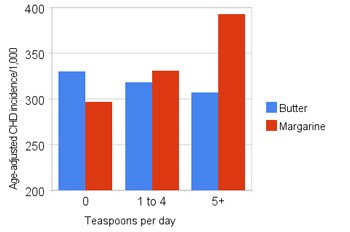As dairy breeders, we pay special attention to the nutritional needs of our dairy herds. As food consumers, we are also well aware of the responsibility of keeping ourselves and our families healthy. It sometimes feels like being placed between a rock and a hard place. This is especially true when we read headlines that vilify farmers or the food we produce. Fortunately, in the case of butter, the pendulum is swinging in a more positive direction.
“Who Can You Believe?”
Over time butter has been blamed for everything harmful from obesity to heart disease. Dr. Ancel Keys – an American scientist who studied the influence of diet on health – believed saturated fats were the leading cause of heart disease because of their high caloric values and cholesterol levels. In 1961, the American Heart Association endorsed Keys’ hypothesis on fat, and the war against saturated fats was on. That same year, Keys was featured on the cover of Time magazine. Needless to say, margarine sales flourished while butter purchases plummeted.
“The Start and End of My Butter Blues!”
I am exactly the right age to remember the campaign against fat that came to the forefront in the 1960s. I distinctly recall the difference that switching to margarine made in the taste of food. Butter had always been at the top of my list for improving bland tasting foods. Gradually my grandparents and parents were won over to the idea of margarine as a healthier alternative to butter. I wish I had known that I could have pointed them to master chef Julia Child. It might have helped. But maybe not. Sometimes the way we accept information is more mystery than recipe!
“Good Sense. Good Science. Butter Brings Them Together Again!”
It has taken a long time, but hindsight regarding butter is becoming 20/20. Using the considerable data collected it is now possible to compare inverse relationships as the consumption of butter dropped and cancer and heart disease soared. Certainly the rise in cancer and heart disease can no longer be blamed on high-saturated-fat butter. Indeed new research points to other contributing factors which need pro-active attention. Common sense needs to become more common.
The New Tune “Bring Butter Back” Is Hitting the Health Charts
Whenever we are in agreement with opinion reversals, we happily report that the change of tune. Today, after additional research and failures to curb obesity and type 2 diabetes, researchers are indeed singing a new tune. So-called heart healthy spreads, hydrogenated vegetable oils, margarine and shortening are under scrutiny. Excess dietary sugar creates insulin and leptin resistance, which can lead to obesity and inflamed arteries – which both raise the risk for a heart attack. It’s not over-dramatic to declare that fighting obesity is a battle we all wage. But not all of us recognize the harm that one or two cans of soda can inflict. (Every American consumes on average 400 8 oz. servings of Coke products per year!) However, let’s stay focused on butter.
“Butter UP!” It’s High Time We Melted Those Butter Myths.”
Currently, both sides of the butter market — production and consumption — are strong. In 2014 butter consumption in the US reached its 40 year peak of 5.6 pounds per capita, compared to 4.1 pounds in 1997. Meanwhile, margarine has fallen to a 70-year low. The butter boom, at least in part, has been attributed to a shift in consumer preferences away from processed foods and back toward natural foods.
“What you Don’t Know About Butter, Could Fill a Crock!”
It’s time to review and revise what you know about butter.
- Almost as harmful as bad science is misleading advertising. Everyone who has a product to sell uses advertising to support purchases by targeted consumers. Imitation products made from vegetables, weeds, seeds or nuts are packaged like real dairy products and have the words “milk” or “dairy” in their names or advertising. They are a choice. But they are definitely not dairy even though advertisers keep churning things up.
- “Overall intake of dairy products was not associated with mortality. A possible beneficial association between intake of full-fat dairy and cardiovascular mortality needs further assessment and confirmation.” (European Journal of Clinical Nutrition (2010) 64, 569–577; doi:10.1038/ejcn.2010.45;)
- There are a lot of fat soluble vitamins in butter. This includes vitamins A, E and K2.
- Butter contains short and medium chain fats which are metabolized differently from other fats. They lead to improved satiety and increased fat burning.
- Butter is an excellent source of a fatty acid called Conjugated Linoleic Acid. This fatty acid has powerful effects on metabolism and is actually sold commercially as a weight loss supplement.
- Conjugated Linoleic Acid has been shown to have anti-cancer properties as well as lowering body fat percentage in humans. However, some studies on CLA show no effect on body composition.
- In 2013, the USDA began the process of banning trans fats from the American food supply.
“Upgrade to a Butter Vocabulary”
New terms that you may want to spread around are Vitamin K2 and Butyrate.
Vitamin K2. As previously mentioned, butter contains Vitamin K2. Vitamin K2 is somewhat rare in the modern diet. It is involved in calcium metabolism. Low intake of K2 has been associated with many serious diseases, including cardiovascular disease, cancer and osteoporosis.
Butyrate: The 4-carbon fatty acid butyrate is created by bacteria in the colon when they are exposed to dietary fiber. Butter, is about 3-4% butyrate. In fact, butyr-ate derives its name from butter.
“Does Butter Make My Butt Look Bigger?”
Nutrition authorities often recommend that we choose low-fat dairy products. That way, we can get the calcium we need without all those “bad” fats and calories. Furthermore, despite the higher calorie content, eating high-fat dairy products is NOT associated with obesity. Modern research results point to high caloric intake and artificial ingredients as the more likely culprits impacting current health challenges. In 2012, a study examined the effects of high-fat dairy consumption on obesity, cardiovascular disease and other metabolic disorders. They discovered that high-fat dairy did NOT increase risk of metabolic disease and was associated with a reduced risk of obesity.
“Always Consider Where It’s Coming From”
Making better choices is what makes life such a challenge and an opportunity. Always consider where the information you’re buying into is coming from. Try to avoid agendas of the information provider. Obviously The Bullvine has a definitely pro-dairy viewpoint. Having said that, the choice to accept, reject or react is up to you! With instant access to news, we are bombarded with information 24/7. We need to understand that headlines sometimes are aimed at sensationalism and are not necessarily scientific fact. Furthermore, when it comes to eating, you can have too much of a good thing. Just because something is good for you, it doesn’t follow that you should overindulge. But, having said that, there are some well-supported reasons for choosing butter.
“Butter is the Source for GOOD Fats.”
Healthy Saturated Fats The “war” against saturated fat was NOT based on real science. And speaking of good, there are good fats, and there are bad fats for us to learn to recognize. Saturated fats raise HDL (the good) cholesterol and change the LDL from small, dense (very bad) to Large LDL, which is benign.
Butter Does Your Heart Good
Recent studies suggest that there is no association all between saturated fat and cardiovascular disease. Unfortunately in our misguided enthusiasm we replaced healthy butter with unhealthy highly processed Trans fats. Trans fats are the bad guys and cause all sorts of diseases. In the Framingham heart study, they examined the effects of butter and margarine on cardiovascular disease.
Margarine significantly increased the risk of cardiovascular disease, while butter had no effect.
Another study revealed that high-fat dairy consumption reduced the risk of heart disease by a whopping 69%, most likely due to increased Vitamin K2 intake.
Conclusion: “You can’t Beat Butter.”
Well, actually you can beat butter but in terms of better eating, butter bashing has gone bye, bye!
In all the hype over good and bad, we sometimes are told or assume that if it tastes good it must be bad for you. It’s important to weigh the facts and make responsible choices. Allowing butter to regain its place at the table, is a win-win-win for science, health and good taste.
The Bullvine Bottom Line
It`s time to bury the myth that butter is bad for you right along with the accompanying threats, scare tactics and alarm bells. The information is out there. It is based on real science and makes good sense and most importantly you can declare with confidence, “If you know what’s good for you …. eat butter!”
Get original “Bullvine” content sent straight to your email inbox for free.








![disease-butter[1]](https://www.thebullvine.com/wp-content/uploads/2014/08/disease-butter1.gif)











Leave a Reply
You must be logged in to post a comment.